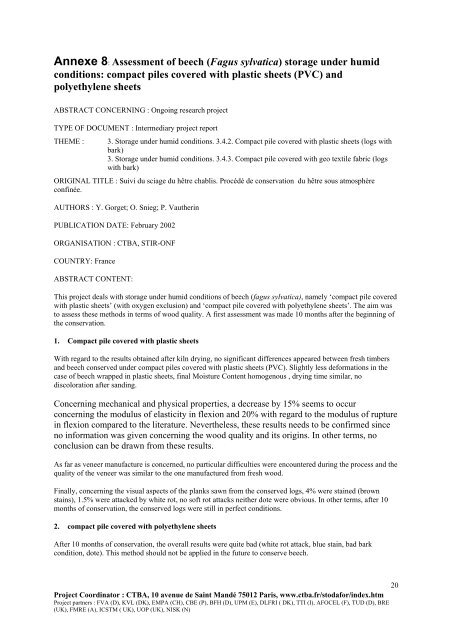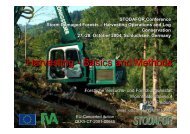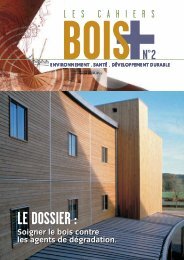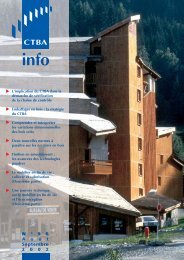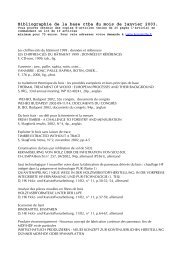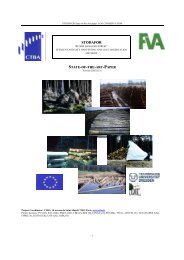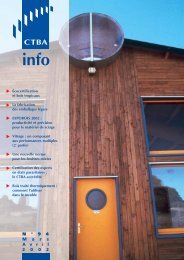Deliverable 6: List of ongoing experiments - Ctba
Deliverable 6: List of ongoing experiments - Ctba
Deliverable 6: List of ongoing experiments - Ctba
You also want an ePaper? Increase the reach of your titles
YUMPU automatically turns print PDFs into web optimized ePapers that Google loves.
Annexe 8: Assessment <strong>of</strong> beech (Fagus sylvatica) storage under humid<br />
conditions: compact piles covered with plastic sheets (PVC) and<br />
polyethylene sheets<br />
ABSTRACT CONCERNING : Ongoing research project<br />
TYPE OF DOCUMENT : Intermediary project report<br />
THEME : 3. Storage under humid conditions. 3.4.2. Compact pile covered with plastic sheets (logs with<br />
bark)<br />
3. Storage under humid conditions. 3.4.3. Compact pile covered with geo textile fabric (logs<br />
with bark)<br />
ORIGINAL TITLE : Suivi du sciage du hêtre chablis. Procédé de conservation du hêtre sous atmosphère<br />
confinée.<br />
AUTHORS : Y. Gorget; O. Snieg; P. Vautherin<br />
PUBLICATION DATE: February 2002<br />
ORGANISATION : CTBA, STIR-ONF<br />
COUNTRY: France<br />
ABSTRACT CONTENT:<br />
This project deals with storage under humid conditions <strong>of</strong> beech (fagus sylvatica), namely ‘compact pile covered<br />
with plastic sheets’ (with oxygen exclusion) and ‘compact pile covered with polyethylene sheets’. The aim was<br />
to assess these methods in terms <strong>of</strong> wood quality. A first assessment was made 10 months after the beginning <strong>of</strong><br />
the conservation.<br />
1. Compact pile covered with plastic sheets<br />
With regard to the results obtained after kiln drying, no significant differences appeared between fresh timbers<br />
and beech conserved under compact piles covered with plastic sheets (PVC). Slightly less deformations in the<br />
case <strong>of</strong> beech wrapped in plastic sheets, final Moisture Content homogenous , drying time similar, no<br />
discoloration after sanding.<br />
Concerning mechanical and physical properties, a decrease by 15% seems to occur<br />
concerning the modulus <strong>of</strong> elasticity in flexion and 20% with regard to the modulus <strong>of</strong> rupture<br />
in flexion compared to the literature. Nevertheless, these results needs to be confirmed since<br />
no information was given concerning the wood quality and its origins. In other terms, no<br />
conclusion can be drawn from these results.<br />
As far as veneer manufacture is concerned, no particular difficulties were encountered during the process and the<br />
quality <strong>of</strong> the veneer was similar to the one manufactured from fresh wood.<br />
Finally, concerning the visual aspects <strong>of</strong> the planks sawn from the conserved logs, 4% were stained (brown<br />
stains), 1.5% were attacked by white rot, no s<strong>of</strong>t rot attacks neither dote were obvious. In other terms, after 10<br />
months <strong>of</strong> conservation, the conserved logs were still in perfect conditions.<br />
2. compact pile covered with polyethylene sheets<br />
After 10 months <strong>of</strong> conservation, the overall results were quite bad (white rot attack, blue stain, bad bark<br />
condition, dote). This method should not be applied in the future to conserve beech.<br />
20<br />
Project Coordinator : CTBA, 10 avenue de Saint Mandé 75012 Paris, www.ctba.fr/stodafor/index.htm<br />
Project partners : FVA (D), KVL (DK), EMPA (CH), CBE (P), BFH (D), UPM (E), DLFRI ( DK), TTI (I), AFOCEL (F), TUD (D), BRE<br />
(UK), FMRE (A), ICSTM ( UK), UOP (UK), NISK (N)


